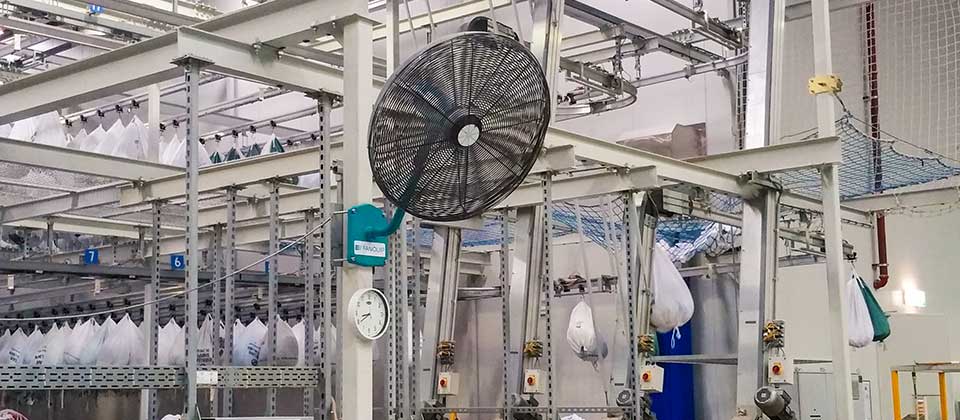Figuring out the right air movement solution for your working environment can be challenging with the plethora of options available. It’s crucial to understand the differences between industrial fans and blowers, as they each have unique properties and functions. In this post, we aim to clarify these differences, helping you make an informed decision for your specific needs.
What is a Blower?
Blowers, particularly blower fans, are designed to move air through ductwork using impellers. These impellers, driven by a blower motor, force air through the blower housing by utilising centrifugal force. This allows blowers to move large volumes of air at high static pressures.
Types of Blowers
There are mainly two types of blowers: centrifugal and regenerative.
- Centrifugal Blowers: Air enters the centre of the impeller and is then pushed out perpendicularly. They are subdivided into volume and pressure blowers.
- Volume Blowers: Ideal for moving large amounts of air in low static-pressure environments.
- Pressure Blowers: Create a positive pressure in sealed environments, suitable for processes requiring less CFM but higher static pressures than axial fans can offer.
- Regenerative Blowers: These operate uniquely, trapping air between impeller blades and pushing it both inward and outward. They can act as pressure or vacuum blowers.
Main Uses of Blowers
- High-Pressure Blower: Suitable for manufacturing processes, production lines, and cooling.
- Low-Pressure Volume Blower: Used for cooling motors, electrical cabinet ventilation, and removing welding smoke.
- Regenerative Blower: Ideal for wastewater aeration, vacuum cleaning systems, and air knives.
What is an Industrial Fan?
Industrial fans cover a wide range of styles and applications.
- Axial Fans: These work like a traditional fan, using rotating blades to draw air in the back and force it out the front, creating a large volume of airflow at low pressures.
- Centrifugal Fans: Similar to a centrifugal blower but air enters along the axis and is pushed out at an angle by the centrifugal force of the blades.
- Wall Exhaust Fans: Used in enclosed buildings for removing hot or contaminated air.
- Inline Duct Fans: Installed with ductwork to assist air movement.
- Ceiling and HVLS Fans: Direct air from the ceiling downwards for better air circulation.
- Roof-Mounted Axial Fans: Pull air up and out of large buildings.
- Air Circulation Fans: Most common, used to keep air moving horizontally.
- High-Velocity Fans: Used for cooling processes, personnel cooling, and ventilating hot areas.
Blower Fans vs Exhaust Fans
When selecting the right equipment, it’s important to consider the specific application. Fans and blowers have distinct functions and are not always interchangeable. Each type is tailored for particular use cases.
| Feature | Blower Fans | Industrial Fans |
| Primary Function | Primarily designed to move air at high pressure, often through ductwork. | Designed to move large volumes of air, generally at lower pressure. |
| Air Flow Characteristics | Produce a directed flow of air at a high pressure ratio. | Provide a more diffused airflow, suitable for general air circulation. |
| Pressure | Typically generate higher pressure, suitable for specific, targeted applications. | Operate under lower pressure, ideal for widespread air distribution. |
| Volume | Move air in controlled volumes, often in contained spaces. | Capable of moving large volumes of air across open spaces. |
| Applications | Often used in HVAC systems, pneumatic conveying, and in confined areas. | Commonly used for ventilation in large spaces like warehouses, factories. |
| Efficiency | More efficient in high-pressure applications. | More efficient in moving large amounts of air with less energy. |
| Design | Typically includes a housing, impeller, and drive assembly. | Simpler design, often consisting of blades, motor, and housing. |
| Noise Levels | Can be noisier due to high-pressure air movement. | Generally quieter as they move air at a lower pressure. |
| Construction | Often more robust to handle higher pressure. | Built to accommodate larger spaces with varied construction depending on type. |
If you’re unsure about the best option for your needs, feel free to contact our product specialists at Fanquip. We are here to ensure you get the exact fan or blower suited for your application, whether it’s for HVAC systems, industrial processes, or specific location requirements within your commercial or industrial setting.
If you are not sure what your project needs, use our Product Finder and one of our ventilation specialists will be happy to guide you.
